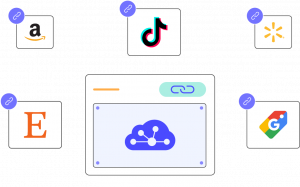Wondering how to sell on Amazon without inventory? For many online sellers, the upfront cost of buying stock, storage fees, and the risk of unsold items can be a huge challenge.
Luckily, there are simple ways to sell items on Amazon without inventory yourself. Whether it’s through dropshipping, Amazon FBA, or offering digital and print-on-demand items, you have options. In this blog post, we’ll cover the 6 best methods to sell on Amazon without inventory in 2025. By the end, you’ll know how to start or grow your business—without the stress of managing stock.
6 Methods to Sell on Amazon without Inventory
There are many models of how to sell on Amazon without inventory. In this guide, we will mention 6 most common models. Let’s thoroughly read to get which one is right for your business.
1. Dropshipping
With dropshipping, you can list products on Amazon without holding any inventory. When a sale happens, you purchase the item from a third-party supplier who ships it directly to the customer. This method helps you avoid upfront inventory costs and keeps overhead low. However, you must adhere to Amazon’s dropshipping policy, ensuring you are the seller of record and handle customer service and returns.
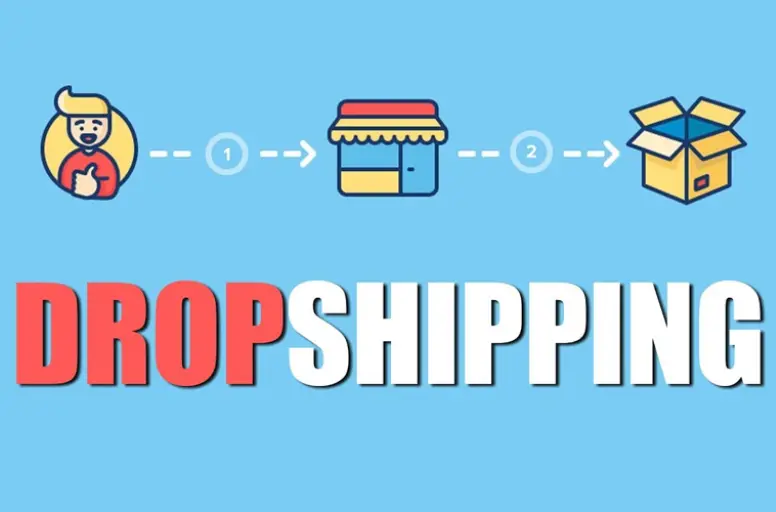
Things to know before dropshipping on Amazon:
- You must be identified as the seller of record for all products. Your business name must appear on all invoices, packing slips, and external packaging sent to customers.
- Any packaging or invoices must not contain information identifying a third-party supplier. This includes removing any branding or contact details from the supplier
- As the seller, you are responsible for handling customer service and processing returns. This includes accepting returns and addressing any customer inquiries or issues.
- Amazon strictly prohibits dropshipping from other retailers (e.g., Walmart, Home Depot), where the retailer ships directly to customers using their branding. This practice can lead to account suspension if customers receive products with labels from these retailers.
Dropshipping offers several benefits but still has some drawbacks for Amazon sellers, such as:
Pros | Cons |
Low startup costs: Since there is no need to purchase inventory upfront, you can start a dropshipping business with minimal investment. | Limited control over the supply chain: You are relying on your supplier to ship the product to your customer on time and in good condition. |
No inventory management: This eliminates the costs and complications associated with warehousing and inventory management. | High competition: Dropshipping is a common business model, so the competition is fierce. Therefore, you will need to work hard to stand out from the crowd and attract customers. |
Wide product selection: You can source products from multiple suppliers and expand their product catalog easily. |
Case study
Product: Yoga mat
Step 1: Research and Product Selection
Objective: Identify a profitable product, like yoga mats, that has consistent demand and low competition.
- Do some market research. Use tools like Amazon Product Opportunity Explorer AMZScout to evaluate yoga mats on Amazon. Look for high-demand, low-competition niches within the yoga mat category (e.g., eco-friendly mats, travel mats, or extra-thick mats).
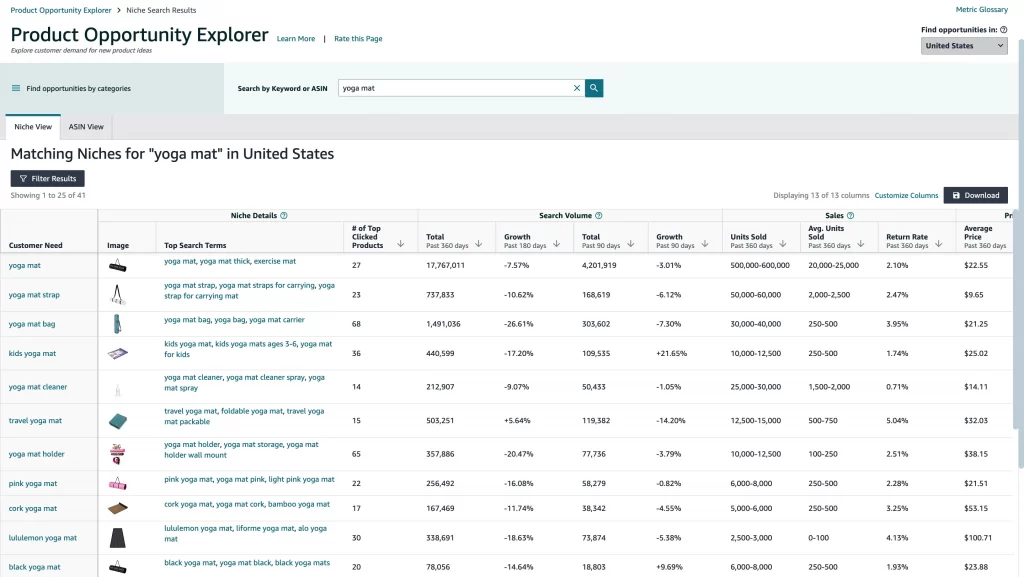
- Research suppliers. Find reliable suppliers who can fulfill orders directly to Amazon customers. Alibaba, AliExpress, and SaleHoo are popular platforms for sourcing. Look for suppliers with good ratings, verified status, and competitive pricing.
Tip: Ensure the yoga mat you choose has unique features that can be highlighted in your listing (e.g., “non-slip,” “biodegradable material”).
Step 2: Create an Amazon Seller Account
Objective: Set up a professional Amazon seller account to access features like the Buy Box, advanced analytics, and advertising tools.
- Set up your Amazon Account. Visit Amazon Seller Central and create a Professional Seller account, which costs $39.99 per month. This plan is recommended for dropshipping as it allows you to list unlimited products and offers more tools than the Individual plan.
- Verification Process: Complete the verification by providing necessary documentation such as ID, business information, and bank account details.
Tip: Ensure all documents match the information provided to avoid delays.
Step 3: List Your Product on Amazon
Objective: Create an optimized product listing to attract potential customers.
- Create your listings. Go to your Seller Central dashboard, and choose “Add a Product.” If your yoga mat is unique, select “Create a new product listing.”
- Write product titles. Incorporate relevant keywords (e.g., “Eco-Friendly Non-Slip Yoga Mat”). Use tools like Helium 10’s Keyword Research to identify high-volume keywords.
- Write bullet points & description. Highlight the benefits of the yoga mat (e.g., “Ideal for beginners and professionals,” “Includes carrying strap”).
- Upload product images. Upload high-quality, professional images that showcase different angles of the yoga mat. You can use free tools like Canva to enhance visuals.
Tip: Make use of Amazon’s A+ Content feature if available, which allows for enhanced product descriptions and visuals and improve conversion rates.
Step 4: Find a Supplier for Dropshipping
Objective: Partner with a reliable supplier who can fulfill orders directly to Amazon customers while meeting quality and shipping standards.
- Contact a supplier. Reach out to suppliers on platforms like Alibaba. Ensure they offer dropshipping services and have a record of quick and reliable shipping.
- Negotiate terms. Discuss minimum order quantities, pricing, and shipping times. Aim for suppliers who can provide tracking numbers and offer quick delivery options.
- Set Up Agreements: use platforms like Oberlo (for AliExpress) to automate the dropshipping process or integrate with Amazon’s API for direct order fulfillment.
Tip: Always request a sample before finalizing any agreement. This ensures the yoga mats meet your quality standards.
Step 5: Automate Inventory Management and Orders
Objective: Keep your Amazon listings synchronized with your supplier’s inventory to avoid overselling.
- Inventory Management Tools: Use software like LitCommerce to track inventory levels across your web store and Amazon.
- Order Management: Set up automatic order forwarding through apps like Oberlo or DSers if you are using AliExpress. For other suppliers, ensure they receive your orders promptly via an automated system or a manual email process.
Step 6: Setting Up the Price
Tip: Monitor supplier stock levels closely, especially during peak periods like holidays, to maintain inventory accuracy.
You should set a competitive yet profitable price for your yoga mat while considering Amazon fees, supplier costs, and market trends. I highly recommend that your price covers all costs and yields a reasonable profit margin (aim for at least 20-30%).
Ok, let’s set up price for a yoga mat.
- Product Cost: Let’s assume your supplier charges $10 per yoga mat (including shipping).
- Amazon Fees: For most categories, Amazon charges approximately 15% of the selling price as a referral fee. There may also be a fixed closing fee, usually around $1.80 for standard items.
- If you plan to sell the yoga mat for $25:
- Referral Fee = $25 × 15% = $3.75
- Fixed Closing Fee = $1.80
- If you plan to sell the yoga mat for $25:
- Add Up the Costs:
- Product Cost: $10
- Amazon Fees: $3.75 (referral fee) + $1.80 (closing fee) = $5.55
- Total Cost = $10 (product) + $5.55 (Amazon fees) = $15.55
- Calculate the Selling Price to Reach $25 Total Cost:
- To reach a total cost of $25, you need to include your profit margin. If $15.55 covers your base costs, the remaining portion should be your profit.
- Profit Needed = $25 (target cost) – $15.55 (total expenses) = $9.45
- Set the Selling Price:
- Now, add your desired profit margin to the total base cost:
- $25 + $9.45 = $34.45
- Round this up slightly for a more appealing price point, if needed (e.g., $34.99).
- Now, add your desired profit margin to the total base cost:
Set your price at $34.99 to ensure that after Amazon fees and product costs, your total expenses are exactly $25, and you have a clear profit margin of $9.45 per sale.
Understand the Dropshipping Selling Model, so why Not Start Now?
LitCommerce handles listing management, inventory, and order sync, helping sellers just focus on Marketing. Sounds promising, right?
2. Amazon FBA
The next model you should consider for selling items on Amazon without inventory is Amazon FBA (Fulfillment by Amazon). Amazon provides this service to help sellers with storage, packaging, and shipping assistance. With Amazon FBA, you can send their products to Amazon’s fulfillment centers, where the items are stored until they are sold.
To sell products without inventory on Amazon through FBA, you must comply with the similar policies as dropshipping. However, there are additional requirements:
1. Inventory ownership
- All products sent to Amazon fulfillment centers must be recorded as your own inventory, even if they come directly from a supplier. You are responsible for any inventory listed under your account.
2. Labeling and packaging compliance
- You must ensure that all products shipped to Amazon’s fulfillment centers are correctly labeled with Amazon FBA barcodes and packaged according to Amazon’s guidelines. This involves coordinating with your supplier to apply the necessary labels and use compliant packaging.
3. Fulfillment compliance
- All items sent to Amazon’s warehouses must follow Amazon’s FBA shipping and packaging standards, which include specific requirements for box dimensions, weight limits, and protective packaging to prevent damage.
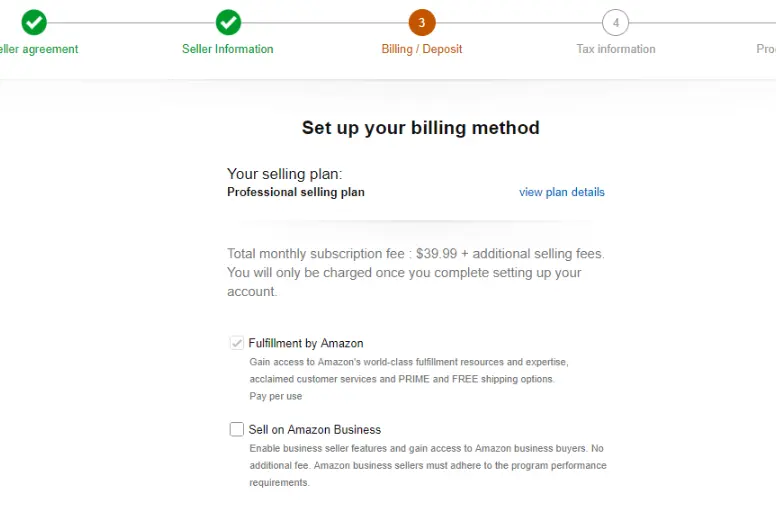
When leveraging Amazon FBA to address how to sell stuff on Amazon without inventory, you can enjoy several benefits. Nevertheless, like any other model, Amazon FBA also has certain disadvantages.
Pros | Cons |
Fulfillment infrastructure: Amazon has a robust fulfillment network that allows you to use its advanced logistics and shipping capabilities. | High costs: Amazon FBA charges various fees, including storage fees, fulfillment costs, and referral fees. |
Prime eligibility: Products fulfilled by Amazon FBA are eligible for Amazon Prime’s fast and free shipping, which can attract more customers. | Long-term storage fees: Amazon charges extra for items that have been stored in its warehouses for more than 60 days. This can be a problem for sellers with slow-moving inventory. |
Global reach: Amazon FBA enables sellers to reach customers worldwide by utilizing Amazon’s international fulfillment centers. | Not suitable for small businesses or slow-selling products: This is because of inventory fees that may be high |
To start selling on Amazon and know more about Amazon FBA fees, read these articles: How to start an Amazon FBA business and Amazon seller fees.
Case study
Product: Dress
First, find a reliable supplier who offers trendy styles and can fulfill orders through Amazon warehouses. Choose a supplier with a diverse range of colors, sizes, and styles to attract a wider audience.
After selecting your supplier based on your research and budget, purchase a bulk quantity of popular styles. The supplier will then ship your inventory to an Amazon FBA warehouse.
Next, create detailed listings for each dress on Amazon. Use high-quality photos with models, size charts for accurate fitting, and detailed descriptions highlighting the materials and care instructions.
When a customer places an order, Amazon’s FBA system picks, packs, and ships the dress from its warehouse. After deducting FBA fees (storage, pick & pack, shipping), referral fees (around 15%), and other costs, you’ll receive the remaining profit.
- Cost per dress (bulk wholesale): $20
- Selling price: $50
- Amazon FBA fees (estimated): $5 (storage, pick & pack, shipping)
- Amazon referral fee: $7.50
- Other costs: $1
Profit per unit: $16.50
Read more: How Much Do Amazon Sellers Make?
3. Third-Party logistics company
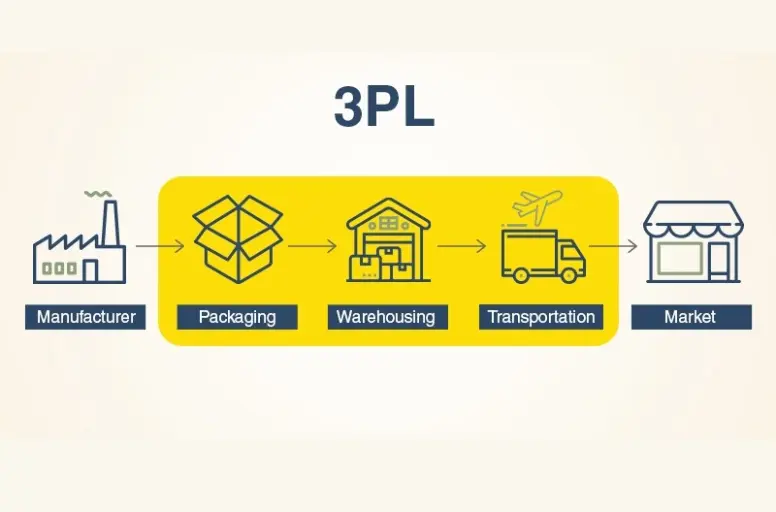
A Third-Party Logistics (3PL) company is a service provider that offers storage, order fulfillment, and shipping services to businesses. When selling on Amazon without inventory, the seller does not hold physical stock of their products. Instead, they rely on a 3PL company to store the products and fulfill customer orders. Here’s how it typically works:
- The seller teams up with a 3PL company to handle their products.
- The 3PL company stores and manages the inventory for the seller.
- When a customer orders on Amazon, the 3PL company fulfills the order.
- The 3PL company handles packing and shipping directly to the customer.
- The seller focuses on sales, marketing, and customer service, while the 3PL takes care of logistics and order fulfillment.
In the context of how to sell on Amazon without inventory, using 3PL services gives a lot of benefits. However, this model still comes with several drawbacks, as you see in the table:
Pros | Cons |
Convenience: 3PLs handle the entire fulfillment process. This frees up your time to focus on other aspects of your business, such as marketing and sales. | Cost: 3PLs charge fees for their services, which can add up to a significant expense. |
Expertise: 3PLs have the expertise and experience to fulfill orders quickly and efficiently. They also have access to a network of warehouses and shipping carriers. | Reliance on a third party: When you use a 3PL, you are relying on another company to fulfill your orders. If the 3PL makes a mistake, it can destroy your reputation and lead to lost sales. |
Expertise: 3PLs have the expertise and experience to fulfill orders quickly and efficiently. They also have access to a network of warehouses and shipping carriers. | Lack of control: Getting to know how to make money on Amazon without inventory due to 3PLs, you may have less control over the fulfillment process. |
Flexibility: 3PLs offer a variety of services to meet your specific needs. For example, some 3PLs offer kitting and assembly services, while others offer custom packaging and labeling. | Complexity: Managing a 3PL relationship can be complex, especially if you are working with multiple 3PLs. |
Case study
Product: Handmade jewelry
You are a fashion entrepreneur who curates stylish, trend-driven dresses from a trusted supplier specializing in high-quality, sustainable fabrics. You partner with a third-party logistics (3PL) company that stores, packages, and ships clothing items professionally.
On Amazon, you create eye-catching listings for your dresses, using high-quality images that showcase different angles, fits, and fabric details. Each listing includes descriptions emphasizing the eco-friendly materials and stylish design, appealing directly to your target audience.
When a customer places an order, your supplier ships the dress directly to the 3PL warehouse. The 3PL then takes over, ensuring the dress is packaged with your branded materials and meets Amazon’s FBA requirements. The 3PL ships the dress to the customer, maintaining quick delivery times and high packaging standards.
Costs Breakdown:
- Cost per dress (from supplier): $15
- Selling price: $35
- 3PL costs: $7 per unit (includes storage, packaging, and shipping)
Profit per Unit:
Profit Calculation: $35 (selling price) – $15 (supplier cost) – $7 (3PL cost) = $13 profit per unit.
4. Sell digital items
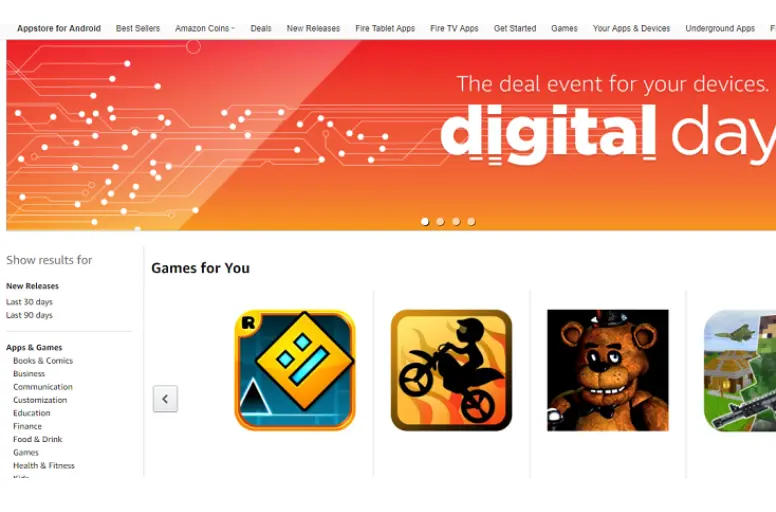
Digital products are items that exist in digital form, such as ebooks, audiobooks, music, digital art, software, online courses, templates, or printable items. Of course, digital items do not always need physical storage or shipping. That’s why this model has become a popular strategy for those who are struggling to find a way to answer the question, “How do I sell on Amazon without inventory” or how to make money on Amazon without writing.
Here are the key steps involved in how to sell on Amazon without inventory through digital products:
- Register as an Amazon seller: You need to have an Amazon seller account to gain access to the Seller Central dashboard.
- Choose the appropriate platform: You need to choose the right Amazon platform for your digital product; for instance, use Kindle Direct Publishing (KDP) for ebooks, Amazon Music for digital music, or Merch by Amazon for digital art. You can also make money on Amazon without writing using alternative approaches like outsourcing content creation or using public domain works.
- Create your digital product: You need to follow Amazon’s guidelines for formatting, content, and metadata to create your digital product.
- Upload your digital product: You have to upload your digital product to the appropriate platform within Amazon and set your pricing.
There are several considerable benefits if you choose digital products as a way to become an Amazon seller without inventory. However, how to sell on Amazon without inventory through digital items still has a few drawbacks. Refer to the table below to gain a clear understanding of this model’s strengths and weaknesses:
Pros | Cons |
Trust and credibility: Amazon is a trusted brand and the best selling platform worldwide. Thus, customers are more likely to buy digital products from Amazon than from an unknown website. | Competition: The digital products market is very competitive, so it can be hard to stand out from the crowd. |
High-profit margins: Digital items have meager costs of goods sold so that you can generate high-profit margins on your sales. | Piracy: Digital items are easy to pirate so others can steal your best-selling products. As a result, you may reduce profits. |
Repeated sales: Digital products can be sold repeatedly without inventory, allowing creators to generate passive income and maximize product value | Refunds: Amazon is known for its generous refund policy, meaning customers can quickly return digital products for a full refund. |
Case study
Product: E-book on bonsai tree care
Start by crafting a comprehensive e-book brimming with valuable information on caring for these miniature trees. Cover essential topics like watering, pruning, repotting, and even pest control. Ensure your e-book is professionally formatted for a seamless reading experience across various devices. Consider an editor’s touch to polish the content and grammar.
Next, head to Amazon.com and create a free KDP account, your gateway to e-book publishing. Here, you’ll fill in the details that bring your e-book to life: a catchy title, your author name, a captivating description highlighting the benefits for readers, and eye-catching cover art to grab attention.
After that, set your desired selling price at $4.5, keeping in mind that Amazon typically offers royalties between 35% and 70% for e-books priced between $2.99 and $9.99. Our advice is that you should get 70% royalties for more money. Once everything is polished, upload your formatted e-book and hit publish.
- Selling prices: $4.5
- Royalties: 70%
Profit per unit: $3.15
5. Sell print-on-demand products

The final model of how to sell products on Amazon without inventory relates to print-on-demand (POD) items. POD refers to offering customized products that are produced and shipped only when an order is received. You earn a profit from the difference between the product’s cost and the price you set on Amazon. Here’s how it typically works:
- Choose a print-on-demand provider that integrates with Amazon’s platform. Popular providers include Printful, Amazon Merch on Demand, and Printify.
- Use a design tool or hire a graphic designer to make unique and appealing designs.
- Connect your print-on-demand provider with your Amazon seller account.
- When a customer places an order, the print-on-demand provider receives the order details, produces the customized items, and ships it directly to the customer on your behalf.
Like any other model, selling print-on-demand products on Amazon without inventory offers both advantages and disadvantages, including:
Pros | Cons |
Wide product selection: Print-on-demand has a wide range of customizable products. So, it gives you the flexibility to offer diverse options to customers. | Quality control: Controlling print-on-demand product quality is challenging when working with multiple suppliers, as physical inspection is necessary before shipment |
Easy order fulfillment: Once you’ve set up your print-on-demand business on Amazon, fulfilling orders is as simple as a few clicks. | Shipping delays: Print-on-demand products can take longer to ship than other types of products, mainly if your supplier is located in another country. |
Reduced time to market: With print-on-demand, you can quickly bring new designs and products to market. There’s no need to wait for inventory to be manufactured and shipped. |
Case study
Product: Funny cat T-shirts
First, design some hilarious cat-themed graphics using design software. After have your unique design, sign up for a free Merch by Amazon (MBA) account to upload your designs and manage your business. Choose the perfect canvas – t-shirts, hoodies, and more – in various colors for your cat masterpieces. Upload your high-quality, transparent background PNG files following MBA’s guidelines. Craft catchy titles and detailed descriptions highlighting the humor and quality of your cat shirts.
Set a competitive price that balances production costs, MBA’s royalty rates, and your desired profit margin. When a customer discovers your roar-some cat shirts and places an order, MBA takes over. They’ll print your design, handle packaging, shipping, and even customer service. Finally, after Amazon deducts their fees, you’ll earn a profit on each perfectly matched cat lover and their new shirt.
- Cost per t-shirt (MBA printing): $3
- Selling price: $20
- Amazon fees (estimated): $5 (printing, fulfillment)
- Amazon referral fee (estimated): $3 (around 15% for clothing)
- Other costs: $1 (design platform subscription)
Profit per unit: $8
6. Amazon Associates Program (affiliate marketing)
The Amazon Associates Program is an excellent way for you to earn money by promoting Amazon products without holding any inventory. It’s Amazon’s affiliate marketing program that allows you to earn commissions by recommending products and driving traffic to Amazon.
Amazon Associates is an affiliate marketing program where you earn a commission for every sale made through your referral links. Instead of managing inventory or shipping products yourself, you promote Amazon products on your blog, social media, or other online platforms. When someone clicks on your affiliate link and makes a purchase, you earn a percentage of the sale.

Here is how to get started with Amazon Associates:
- Sign Up for the Amazon Associates Program
- Visit Amazon Associates and sign up for an account. You’ll need to provide details like your website, social media channels, or blog where you plan to share affiliate links.
- Amazon will review your application, and once approved, you’ll have access to the dashboard where you can start finding products to promote.
- Choose the Right Products to Promote
- Research popular products. Find products that are trending or have high sales volume. You can focus on a niche that aligns with your audience, such as tech gadgets, fitness gear, or fashion items.
- Check commission rates. Amazon offers different commission rates based on product categories. Choose products with a reasonable price and good commission percentage to maximize earnings.
- Create Engaging Content
- Write product reviews. Create detailed product reviews on your blog or website, highlighting the benefits and features of the products. Include your affiliate links within the content.
- Social media promotion. Share your affiliate links on platforms like Instagram, Twitter, and Facebook. You can create engaging posts, stories, or videos showcasing how the products can be used.
- YouTube videos. Make product review or unboxing videos and include your affiliate links in the description. Video content tends to engage users more effectively and can drive more clicks.
- Drive Traffic and Optimize Conversions
- SEO optimization: Optimize your blog posts and videos with relevant keywords to increase visibility on search engines.
- Email marketing: Build an email list and send out newsletters with product recommendations and affiliate links. This can help you reach your audience directly and increase conversions.
Case Study
Product: Home Office Desk
You are a content creator specializing in home office setups and productivity tips. You decide to monetize your blog and YouTube channel through the Amazon Associates Program, promoting high-quality, ergonomic home office desks that are popular with your audience.
On your blog, you create an engaging article titled “Top 5 Ergonomic Home Office Desks,” featuring affiliate links to each desk available on Amazon. Each desk is described in detail, highlighting its benefits like adjustable height, sturdy build, and space-saving design. You also create a YouTube video review showcasing the desks in various setups, demonstrating how they can enhance productivity and comfort.
When a visitor clicks on your affiliate link and purchases one of the recommended desks, Amazon processes the order and ships the desk directly to the customer. You earn a commission for every sale made through your referral.
Costs Breakdown
- Commission Rate (for furniture category): 8%
- Average selling price per desk: $200
Profit per Unit
- Profit Calculation: $200 (selling price) × 8% (commission) = $16 profit per sale.
Selling on Amazon Without Inventory vs With Inventory
Selling on Amazon without inventory differs significantly from the traditional selling style with inventory. To gain a clear understanding of the variances between these two approaches, refer to the following comparison table:
Feature | Traditional Selling on Amazon | Selling on Amazon Without Inventory |
Inventory ownership | Seller owns and manages inventory | Having a 3rd party provide/ manage inventory |
Upfront investment | Significant initial investment in inventory | Low upfront investment |
Storage | Seller must have space to store inventory | Seller does not need storage space |
Order fulfillment | Seller is responsible for shipping orders to customers | Third-party supplier ships orders directly to customers |
Profit margins | Typically higher profit margins | Typically lower profit margins |
Customer service | Seller is responsible for customer service | Seller is responsible for customer service, but may also rely on their supplier for assistance |
Tips for How to Sell on Amazon Without Inventory
Now, we will explore four key tips on how to sell on Amazon without inventory:
Select your suppliers carefully
One of the most critical aspects of how to sell on Amazon without buying products is choosing reliable suppliers. Your suppliers are essentially your business partners, and their performance can directly impact your reputation and success. Here are some tips on selecting your suppliers:
- It would be better to look for suppliers with a solid track record of fulfilling orders promptly and accurately. You should consider reputable suppliers like SaleHoo, Worldwide Brands, or AliExpress.
- You should read product reviews and consider ordering samples to assess the quality for yourself.
- It is essential to check the shipping times your suppliers offer. Amazon customers often expect fast shipping. Therefore, it’s vital to work with suppliers who can deliver products within a reasonable time frame, preferably within a few days.
- You need to compare pricing and terms different suppliers offer. Also, pay attention to return policies and warranty terms.
Stay compliant with Amazon’s policies
Compliance is crucial to avoid penalties or account suspension.
As top marketplace for selling products, Amazon has strict policies and guidelines for all sellers, including those practicing how to sell on Amazon without inventory. It would be best if you stayed compliant to avoid penalties or account suspension.
Here are some key aspects of Amazon’s policies to keep in mind:
- You need to ensure your product listings are accurate and up-to-date. Displaying incorrect product information, such as price or availability, can result in negative feedback and harm your seller’s reputation.
- You must stay on top of shipping times and returns. Late shipments or high returns can negatively affect your seller metrics. Be transparent about shipping times and return policies in your product listings.
- Please avoid selling counterfeit or trademarked products, which can lead to legal trouble and account suspension.
Optimize your product listings
You need to optimize product listings to convert potential customers
Optimizing your product listings is essential for attracting and converting potential customers. Here’s how to do it effectively:
- Research and use relevant keywords in your item titles and descriptions. This helps your products appear in Amazon’s search results when customers are looking for items you sell.
- Use high-resolution images that showcase the product from different angles. Clear, professional images can instill confidence in potential buyers.
- Write compelling and informative product descriptions. Highlight the features and benefits of the product, and use persuasive language to encourage buyers.
- Keep an eye on your competitors’ prices and adjust yours accordingly. Competitive pricing can attract more customers.
- Clearly mention that your products are being dropshipped. Amazon allows dropshipping, but it’s essential to be transparent about it. Customers appreciate honesty.
- Experiment with different product listings to see what works best. You can test variations of titles, descriptions, and images through Amazon Manage Your Experiments, Splitly,… to optimize your listings for conversion.
How to Sell on Amazon without Inventory: FAQs
- How to sell on Amazon without selling products?
One way to sell on Amazon without selling physical products is by becoming an affiliate marketer. As an affiliate, you can promote products listed on Amazon and earn a commission for every sale made through your referral link. By creating engaging content, such as product reviews or tutorials, and driving traffic to Amazon through your affiliate links, you can generate income without the need to handle inventory or shipping.
- How to sell on Amazon without being a business?
To sell on Amazon without being a business, you can consider the following options:
- Become an individual seller: Amazon allows individuals to sell products on their platform without the need for a business registration. You can create an individual seller account and list your products for sale.
- Sell as an affiliate: By sharing your unique affiliate links, you can earn a commission for every sale made through your referral.
- Create and distribute merch: Amazon Merch on Demand allows you to design custom apparel and accessories that are printed on-demand. When a customer purchases your design, Amazon handles the printing and shipping, allowing you to earn royalties without the need for inventory 2.
- Sell B2B: If you want to sell to other businesses, Amazon Business is designed to help you reach B2B customers of all sizes.
- Where can I buy products to sell on Amazon?
To buy products to sell on Amazon, you can consider the following options:
- Wholesale suppliers: Contact manufacturers, distributors, or wholesalers directly to purchase products in bulk at wholesale prices. Websites like Alibaba, Thomasnet, and Wholesale Central can help you find suppliers.
- Retail arbitrage: Purchase products from retail stores or online marketplaces at a discounted price and resell them on Amazon at a higher price.
- Private label: Source products from manufacturers and customize them with your own branding. Websites like Alibaba, Global Sources, and Made-in-China can help you connect with manufacturers.
- Dropshipping: Partner with a dropshipping supplier who will handle inventory storage and shipping. When a customer places an order, the supplier ships the product directly to the customer. Platforms like Oberlo and AliExpress offer dropshipping options.
Can you Sell on Amazon without Inventory? Absolutely Yes!
In conclusion, selling on Amazon without inventory can be a viable and profitable business model with the right strategies in place. By carefully selecting reliable suppliers, staying compliant with Amazon’s policies, offering excellent customer service, and optimizing your product listings, you can set yourself up for success in the competitive Amazon marketplace. So, take the plunge and start your journey as an Amazon seller today!
In addition, if you are looking for a tool to help you solve the inventory problem when doing eCommerce business, LitCommerce is the answer for you. To know more about this great tool, contact us now!
Finally, to not miss any interesting information about the eCommerce industry, don’t forget to follow our Blog.


